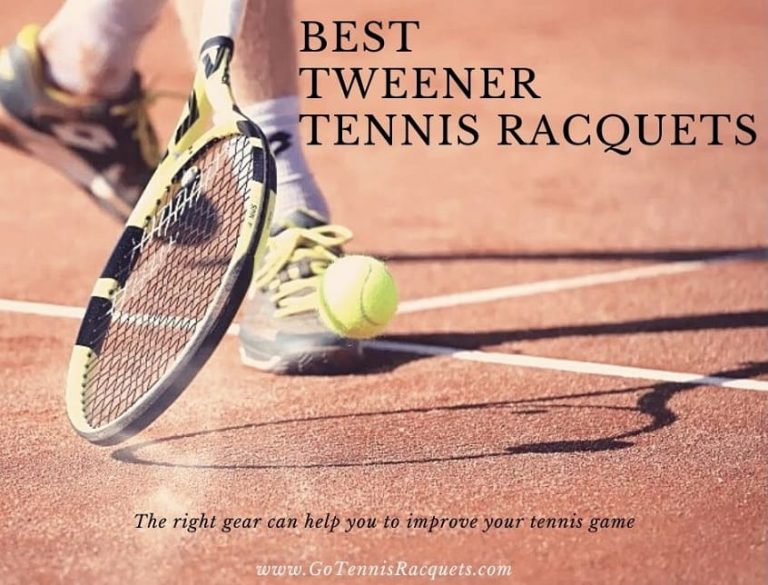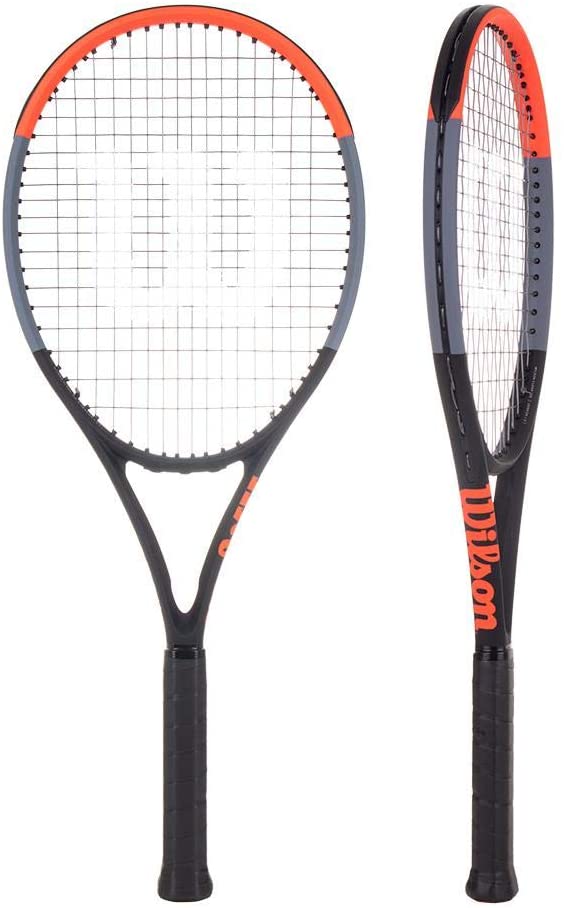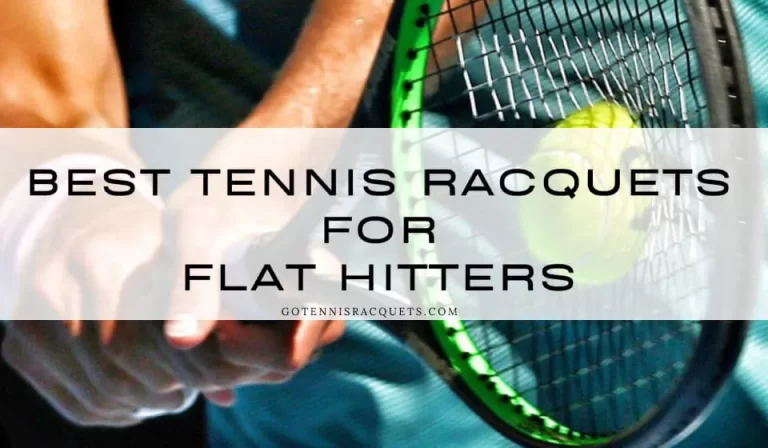Best Tennis Racquets for Left-Handers

Nature has given multiple blessings to left handlers. One of them is that they have an extra advantage in playing tennis is the freedom to open the court easily from the advantage side.
Plus, they can serve out wide as compared to any right-handed. In short, southpaw tennis players got more chances of winning than north paw.
According to the statistics, roughly 10 percent of tennis players are left-handed. That’s the reason we have decided to write reviews of some best tennis racquets for lefties.
People often get confused by the handedness of racquets, but let me make it very clear to you. All racquets can be equally used by southpaws and north paws.
All you have to do is to identify the perfect grip for your racquet.
This article will talk about some famous tennis racquets for left handers along with a tennis grip guide for a southpaw. These tennis racquets have been reviewed on a fair and neutral basis.
Best Tennis Racquets for Left Handers Reviews
1. BABOLAT Pure Aero – Best Racquet for Spin


So, the first one on my list of best tennis racquets for left handers is Babolat Pure Aero which is Rafael Nadal’s favorite tennis racquet.
How come I forgot to mention his favorite racquet brand? Babolat is a tennis racquet brand that international player trusts, so why not you?
Babolat pure aero 2019 has got some nice upgrades. You will notice a fine matte black and yellow finish. This new and upgraded Aero series features an Aero modular beam construction that is there for less wind drag. Therefore, it increases racquet head speed.
Babolat pure aero is a perfect stick for lefty players because of the fact that it features the Babolat’s cortex pure feel, making the response arm friendly at contact.
In order to improve the stability of the racquet, Babolat has incorporated a carbon ply stabilizer. This special stabilizer is added above the throat in order to have more precision and stability during the game.
Moreover, it weighs only 11 ounces and it is 27 inches long making it perfect tennis for the intermediate-level player.
- Head: 100 (in²) / 645 (cm²)
- UnStrung Weight: 10.6oz / 300 g
- String Pattern: 16×19 (16 Mains / 19 Crosses)
- Length: 27in / 68.58cm
- Beam: 23mm / 26mm / 23mm
- Flex: 71
- Composition: Carbon Fiber
- Endorsed by Rafael Nadal
More comfortable and better feel
Deliver shots with great power
[/i2pros][i2cons] Difficult to play flat shots
[/i2cons][/i2pc]
2. HEAD Graphene 360+ Speed PRO – Best for Adults



The new version of HEAD Graphene 360+ speed pro tennis racquets features a more open 18 x 20 string pattern which makes it easier to hit with depth, power, and spin
HEAD Graphene 360 speed pro has been updated with spiral fibers in the frame. This will give improved feelings to players.
The head size measure 100 square inches, giving enough big sweet spot to play with great power and spin.
The updated version of HEAD Graphene promises to deliver excellent control and feel along with power and maneuverability.
Also, you will find that HEAD has slightly reduced the weight of the racquet from 322 to 318 grams. Just because of this reduction in swing weight, you don’t have to put 100% of your efforts into every shot. There is so much to talk about HEAD Graphene speed pro tennis racquet.
Let me tell you one thing, the Speed line of HEAD is the most popular line which has been endorsed by players such as Novak Djokovic who is the number 1 tennis player as ranked by the Association of Tennis Professionals.
- Head: 100 sq in or 645 sq cm
- Weight: 11.6 oz or 329g
- Length: 27 in or 68.58 cm
- Beam: 23-23-23 mm
- Composition: Graphene 360+/Graphite
- Racquet Colors: Black
- String Pattern: 18×20 (Mains x Crosses)
- Swing Speed: Fast
- Grip Type: Head Hydrosrob Pro
With more open stringbed
User friendly and maneuverable
Recommended for beginners and intermediate players
Professional Players Used this Racquet
[/i2pros] [i2cons]No worth mentioning cons yet
[/i2cons] [/i2pc]
3. Wilson Blade 98 – Best for Club Level players


When it comes to tennis racquets for Southpaws Wilson is the brand that strikes the mind first. Of course, Wilson has been a leader in the tennis industry for ages, that’s why they have a tennis racquet for every type of player.
Wilson Blade 98 version 7 is one of the most popular frames that feature innovation with great power and control.
For additional flexibility and a better connected-to-the-ball feel, the Wilson blade 98 frame features FeelFlex technology. This technology features carbon mapping that is strategically placed throughout the hoop of tennis.
For left handers players, you will find a top grip taper that provides a better feel for top handgrip placement. Besides this, Wilson Blade 98 has got good weight distribution because of which it’s a great choice for some volleyers.
So if you are in search of some powerful tennis racquet but you can’t give up on control then Wilson Blade Team 98 can quench your thirst.
- Head: 98 sq in or 632 sq cm
- Weight: 11.4 oz or 323 g
- Length: 27 in or 68.58 cm
- String Pattern: 16×19 (Mains x Crosses)
- Composition: Graphite
- Players : Unisex
- Strung Balance: 1 pts HL
Good feel and stability
Lightweight
More Sweetspots[/i2pros] [i2cons] Hard to swing
[/i2cons] [/i2pc]
4. Wilson Pro Staff 97 Countervail – Best Racquet for Power


Since Wilson is an old name in the tennis field, that’s why they keep upgrading their tennis racquets according to the demand of players.
Similarly, Wilson Pro staff 97 countervail has got a few new up-gradation that will surely blow your mind.
I am sure, you will fall in love with the performance of the Wilson Pro staff 97 countervail tennis racquet. Actually, it’s the lighter version of Pro Staff RF97. It weighs only 11.7 oz, which left-hander players can effectively handle.
The head size is 97 square inches, which means a big sweet spot that delivers shots with more power and less vibration. But if you have a wrist or elbow problem, then it can further worsen the condition.
Like the previous model, it features countervail technology that not only maximizes player energy but also its consistency and precision.
Wilson Pro staff 97 countervail tennis racquet is perfect tennis that enables left-handed tennis players to serve with great power and control.
- Head: 97 sq in or 626 sq cm
- Unstrung Weight: 11.1 oz. / 315 g
- Strung Weight: 11.6 oz. / 330 g
- Length: 27 in or 68.6 cm
- Beam: 21.5-21.5-21.5 mm
- Composition: Braided Graphite, Countervail
- Players: Adult
- String Pattern: 16×19 (Mains x Crosses)
- Flexibility: 65
Easy to swing and spin
Great for playing from all areas of the cour[/i2pros] [i2cons] Because of high stiffness, it is not suitable for players having arm issues.
[/i2cons] [/i2pc]
5. Babolat Pure Drive Plus – Best Lightweight Tennis Racquet


Babolat pure drive plus features a high sweet spot as compared to its other racquets model. This is indeed an important update that will surely benefit players.
Pure drive plus features 27.5 inches in length. This half-inch increase in length makes it a perfect racquet for volleys.
In order to improve the comfort and power of left handed tennis players, Babolat has incorporated the Woofer technology which is frame and string interaction. This way player can maximize their power on every shot including off-center hits.
In addition to this, it gives quiet comfort and a muted response to players. Credit goes to its Cortex Pure Feel system, which incorporates viscoelastic rubber to absorb impact vibration while giving a more direct feel to the player.
It’s so comfortable that even left-handed tennis players can easily use it. Babolat pure drive plus is recommended to be used by intermediate and advanced players who need more power and spin.
- Head: 100 sq in / 645 sq cm
- Length: 27.5in / 70 cm
- UnStrung Weight: 10.6 oz / 301 g
- Strung Weight: 11.1 oz / 315 g
- String Pattern: 16×19 (Mains / Crosses)
- Beam: 23/26/23 mm
- Flex: 69
- Composition: Graphite
Light enough for a natural swing
Perfect for groundstroke
[/i2pros][i2cons] Beginners may experiences difficulty in controlling power
[/i2cons][/i2pc]
6. Yonex-VCore SV 98– Best for Spin & Precision


Yonex VCORE 95 tennis racquet weighs only 11.4 oz in weight. It is one of the lightweight tennis racquets for left handed players. Besides being light it is quite faster in performance as compared to the traditional racquets.
The construction material that is used in the construction of the Yonex VCORE 95 tennis racquet is Namd, which makes it quite flexible. The head is mid in size that is 95 square inches, which makes it the perfect tennis racquet for beginners and intermediate level players.
Besides this, the smaller head size makes it quick to maneuver. Indeed it’s a perfect tennis racquet for volleys. When it comes to spin patterns its 16 x 20 string pattern generates spin according to your power. so that you can aggressively hit targets with full confidence.
Yonex VCORE 95tennis racquet is suitable for beginner and intermediate level players. Its small sweet spot and mid head size make it a perfect racquet for newbie players.
- Head: 95 sq in / 612.9 sq cm
- Length: 27 in / 68.6 cm
- UnStrung Weight: 10.9 oz / 312 g
- Strung Weight: 11.4 oz / 326 g
- String Pattern: 16×20 (Mains / Crosses)
- Beam: 21/21/20 mm
- Flex: 65
- Composition: H.M. Graphite, Nanometric XT, Namd
Maneuverable head
Spin friendly
[/i2pros][i2cons] Not much stable
[/i2cons][/i2pc]
Best Tennis Racquets for Left Handers Buying Guide
Choosing a perfect tennis racquet for left-handed players can be a cumbersome task, especially when you are doing it for the very first time. You have to keep in mind so many factors while buying the best tennis racquet.
Here at (Go Tennis Racquets) we have eased your work, by compiling a brief and concise tennis racquet buying guide. This buying guide will definitely give you peace of mind and you can simply choose the best tennis racquet without any hard work.
So let’s begin!
Headsize
Head size means power.
A larger head size means larger sweet spots and more power. Typical head size ranges between 85 – 115 square inches, where:
• 85-96 sq. in is considered as Midsize
• 96-106 sq. in is considered as Mid Plus
• 107 – 115 sq. in is considered as oversize
Racquets with smaller head sizes offer more control as compared to racquets with larger head sizes.
Length
Usually, the length of a tennis racquet ranges from 26.5 to 29 inches long. Racquets that are longer in length are usually lighter than the standard frames. Plus, they offer more reach on groundstrokes and more power on serve. In addition to this, they have a high swing weight which means extra effort is required to maneuver the racquet.
Weight
Heavier racquets are more powerful and more stable. Plus they deliver less shock. On the other hand, lighter racquets are more maneuverable and spin-friendly.
Racquets that weigh less than or equal to 310gm are considered lightweight racquets whereas more than 320 gm will be termed heavy racquets.
Balance
Head-light racquets are more maneuverable but they are quite heavy. On the other hand, head-heavy racquets are quite light and offer more power on groundstrokes.
Stiffness
The stiffness of the racquet frame is equally an important factor that needs to be considered. If the frame is stiffer, there will be less loss of energy while hitting the ball. But this will send more shock to your hand and arm.
Grip Size
Every individual has born with different hand size. The circumference of handles ranges between 4 1/8 to 4 5/8 inches in diameter. Though the difference is quite minimal it plays a great role in your performance.
If you are holding a racquet of the right grip size, you will be protected from different injuries. A large grip size can strain your muscles, whereas a small grip size can exert unnecessary pressure on the wrist and elbow. So in both cases, injury is there.
Therefore it is advisable to choose racquets according to your grip size.
Handedness
No matter which hand you use, tennis racquets are designed for both righties and lefties. But you have to grip your racquet differently if you are a left-handed player. Grips are simple to understand as they are the mirror image of the right handers grip. For this purpose, below is a small tennis grip guide for southpaws, here you go!
First of all, find the grip. There are two points on your palm where you have to place your racquet. The base knuckle of your index finger and the heel pad of your palm. Draw an imaginary line between these two points; this is called the “grip-change repositioning line”.
Now hold your racquet on this line with its head pointing away from you. Peep in the bottom of the butt cap, and you will see eight sides of handles, which are called “bevels”. The topmost bevel is termed as 1. If you are holding it in the right hand then move it clockwise and named the next second right bevel as 2. If you are holding it in the left hand then move it anti-clockwise and named the next second left bevel as 2.
This is how you will identify different bevels on your tennis racquets. Altogether there are 8 bevels. For left-handed tennis players, these 8 bevels are named as:
• Bevel 1 as Eastern Backhand- used by all court tennis player
• Bevel 2 as Continental Grip- used for volleys, slice, and low balls.
• Bevel 3 as Eastern Grip- used by all court tennis players.
• Bevel 4 as Semi Western Grip- for hitting high bouncing balls.
• Bevel 5 as Full Western Grip
• Bevel 8 as Semi – Western Backhand – for hitting high bouncing balls.
Our Verdict
No matter whether you are lefty or righty, I am sure that our reviews will definitely help you in choosing the best tennis racquet for left handers. Also, the tennis grip guide will also be helpful for you in selecting a racquet of the perfect grip size.
If you are looking for a recommendation, then we will recommend HEAD Graphene 360+ speed Pro tennis racquet, as it is endorsed by the top tennis players including Novak DJOKOVIC and Alexander ZVEREV.


As someone who enjoys both playing tennis and writing, I strive to embody a combination of skillful technique and unwavering perseverance on the court while simultaneously offering valuable observations and reflections to my audience through my articles. My overarching objective is to motivate and encourage others on their individual paths towards tennis success.














